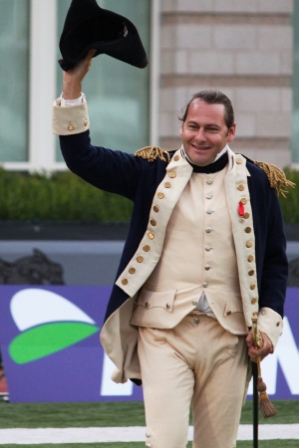Photo by Ally Hill ‘15|The Lafayette

The Gendebien Room in the Skillman Library was about as full as it has ever been. Diane Shaw, college archivist and director of special collections, began her lecture on the “farewell tour” of the Marquis de Lafayette, one in a series of lectures on Lafayette that has become an annual tradition at the college. She swept all present into the past – between years 1824 and 1825, a year in the life of Lafayette.
Shaw lectured on the life and times Marquis de Lafayette as he embarked on a “farewell tour” around America, with hundreds of thousands of citizens turning out to thank Lafayette for his role in the founding of our nation.
Few individuals have been as celebrated in this country as Lafayette was that day in 1824 when President James Monroe, in conjunction with Congress, formally invited Lafayette to return to America. This was a nation Lafayette had fought so hard to create fifty years after the Revolution began. The prospect of returning to the land of his idol, George Washington, excited Lafayette—who did not hesitate to accept.
He was, however, likely unprepared for exactly how grateful the American people were to him. Aside from being awarded $200,000 by Congress, which is just over four million dollars at today’s value, he was also warmly welcomed by everyone he met. Every city did its best to outdo all the others in giving their guest a grand welcome, but the most notable of these was Philadelphia. The city erected sixteen triumphal arches and marched in a parade in Lafayette’s honor, which consisted of nearly 20,000 individuals, with 160,000 others watching on.
During the lecture, Shaw indicated the important part of contention in Lafayette’s visit to America: the issue of slavery. Though Lafayette did not want to embarrass his host nation by making a large public statement against it, he was certain to always treat slaves and free blacks as equals whenever he encountered them, and he did register many complaints against the practice in private. Shaw mentioned that one reason for the escalation of anti-slavery rhetoric and action that occurred later in the century was that Lafayette disapproved of it, and made treating everyone equally a point of honor.
The popularity of these lectures on Lafayette reflects a greater focus on the man for whom this school is named, one spurred on by the idea of Lafayette as a role model.
“Archivist Diane Windham Shaw and Professor Olga Anna Duhl have found depth in the life of Lafayette, so that he is becoming a political model for college faculty and students who supported equal rights, and took brave action in support of his beliefs,” Professor Ilan Peleg of the government and law department said.
Through being a model for the community, Lafayette challenges and inspires members of the school.
“All of us need models, people who inspire us by showing that progressive thinking and risk taking can make a difference in the lives of others,” history professor Robert Weiner said. “Lafayette stands out as a paragon of virtue, eschewing personal gain and power, while serving his country and the cause of liberty to the best of his ability. What an antidote for the cynicism of our age!”



































































































